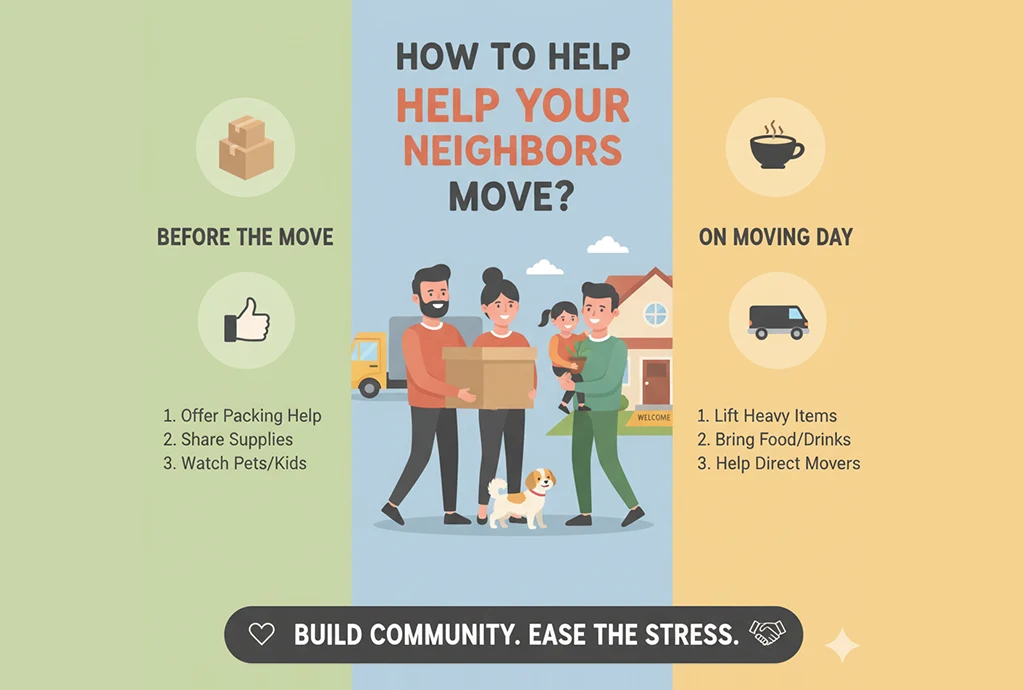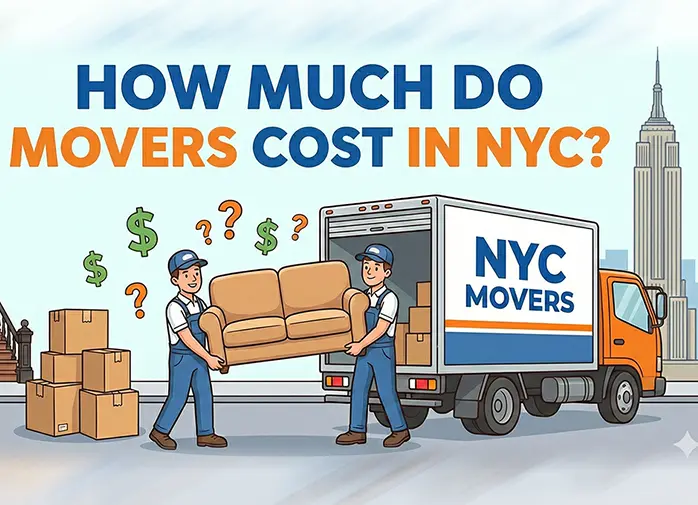How to Make Your Neighbors Move?

Living next to the wrong neighbor can make daily life stressful, noisy, and sometimes unsafe. Perhaps their yard is an eyesore, late-night noise or unsafe behavior disrupts your sleep, or personalities simply clash. Few things are as emotionally draining as feeling trapped in your own home because of someone else’s actions.
You might be wondering if it’s possible to encourage a neighbor to move. While there are ways to resolve conflicts, it’s essential to approach the situation ethically and legally. Harassment, intimidation, or coercion is never acceptable.
This guide focuses on constructive strategies to improve your situation — including communication, mediation, administrative routes, and lifestyle adjustments. And if a move is the best solution, we’ll show how VanLinesMove can make relocating stress-free and secure.
Below are 15 strategies grouped into three categories: Communication & De-escalation, Administrative & Legal Routes, and Positive Alternatives & Lifestyle Changes about how to make your neighbors move!
15 Tips About How to Make your Neighbors Move
Part A — Communication & De-escalation (Tips 1–6)
1. Start with a calm, private conversation
Before doing anything else, try a friendly, one-on-one chat. Aim to:
- Choose a neutral time (not right after an upsetting incident).
- Use “I” statements: “I’ve been having trouble sleeping because of late-night noise,” rather than “You always make noise.”
- Listen as well as talk — there may be causes you don’t know about (illness, new baby, work schedule).
- Offer concrete, practical solutions (quiet hours, moving loud activities indoors).
Why this works: People often respond to simple, civil appeals. A short, empathetic conversation can defuse assumptions and open a path to compromise.
2. Put concerns in writing — neutrally and factually
If talking doesn’t work or the problem recurs, write a polite note or email that:
- Briefly describes the issue (dates/times if relevant).
- States the impact on you (sleep loss, safety concerns).
- Proposes specific remedies and a reasonable timeframe.
- Keeps a copy for your records.
Why this works: A written record demonstrates you took reasonable steps and helps later if you need to involve a landlord, HOA, or authorities. Keep the tone factual — avoid threats, sarcasm, or inflammatory language.
3. Use mediation — neutral third-party facilitation
If direct conversation stalls, offer mediation. Many municipalities and community organizations provide free or low-cost mediation services. A mediator helps both sides:
- Explain their perspectives in a neutral setting.
- Identify practical, mutually acceptable solutions.
- Draft a simple agreement both parties sign.
Why this works: Mediation improves communication and frequently results in compromises that would be hard to achieve in heated one-on-one meetings.
4. Document incidents carefully
Record problems with dates, times, photos (if relevant and lawful), and short notes about the effect. For noise, you can keep a noise-log noting when it starts/ends and how it disrupts you.
Why this works: Solid documentation is persuasive when reporting problems to landlords, HOAs, or local authorities, and helps if legal steps become necessary. Reminder: Do not record private conversations or invade privacy in ways that violate laws in your jurisdiction.
5. Focus on solutions that reduce friction at the source
Sometimes the easiest path is adjusting the environment:
- Soundproofing your home: rugs, heavy curtains, bookcases against shared walls, door draft stoppers, or white-noise machines.
- Rearranging your bedroom or workspace to a quieter side of the house.
- Installing a fence or privacy plantings to address visual or boundary disputes.
Why this works: Environmental changes often reduce daily irritation and buy time while other remedies are pursued. They’re also actions you control and are generally lawful.
6. Build rapport through small gestures
It may feel odd, but small acts of goodwill — sharing baked goods, offering to water plants while they’re away — can change tone. This is not manipulation; it’s community-mindedness. If the problem is rooted in miscommunication or different expectations, a humanizing gesture can break the cycle.
Why this works: It resets the relationship dynamics, makes future conversations easier, and sometimes reveals private reasons for behavior (medical issues, temporary stressors).
Part B — Administrative & Legal Routes (Tips 7–11)
7. Involve the landlord (if applicable) — clearly and professionally
If the neighbor is a tenant in a multi-unit building, report problems to the landlord or property manager. When you do:
- Provide documented incidents.
- Reference lease clauses (quiet hours, nuisance, maintenance).
- Ask what steps the landlord will take and by when.
Why this works: Landlords have a legal interest in keeping properties habitable and free of nuisance. They can issue warnings, require remediation, or — for chronic violations — pursue lease termination.
8. Contact the HOA or community association
If you live in an HOA or similar community, file a formal complaint following their process. Include documentation and request specific enforcement (e.g., compliance with landscaping or noise rules).
Why this works: HOAs have enforcement tools (fines, notices, directives) that can motivate compliance without police involvement. Use the HOA route for code- and rule-based issues first.
9. Understand and use local ordinances — calmly and lawfully
Municipal codes cover noise, property maintenance, trespass, and safety in many places. If the neighbor is violating clear local ordinances (habitual late-night noise, illegal dumping, unsafe structures), you can:
- Confirm the exact ordinance text on your city or county website.
- Report violations to code enforcement or non-emergency municipal lines.
- Provide your documentation and ask for inspections.
Why this works: Code enforcement operates on objective standards rather than private disputes. If a code violation is found, the city can require corrective action.
Important: Only call police for emergencies or ongoing illegal activity that threatens safety. Overuse of law enforcement for neighbor disputes can escalate hostility and is rarely the most constructive first step.
10. Seek legal advice if the issue is serious or persistent
For harassment, threats, property damage, or chronic nuisance that affects health and safety, consult an attorney. They can advise on:
- Civil remedies (injunctions, nuisance lawsuits).
- The strength of your documentation.
- How to present your case to a court or local agency.
Why this works: Legal counsel clarifies your rights and options without exposing you to claims of harassment. Many lawyers offer short consultations at modest cost; some legal aid organizations provide free help for qualifying individuals.
11. Use formal negotiation for a voluntary move (buyouts, relocation assistance)
If you want the neighbor to move voluntarily and the relationship is irreparable, a respectful, lawful, and transparent buyout or relocation offer can work — but approach carefully:
- Make sure you can legally and ethically make the offer (don’t bribe or coerce).
- Start with a conversation (or a written, non-pressure proposal) offering to help with relocation costs or to purchase their property at fair market value, if applicable.
- Use a neutral third party (real estate agent or attorney) to handle finances and documents.
- Offer time and support; moving is disruptive and expensive, and a fair package recognizes that.
Why this works: A fair, voluntary offer avoids conflict and can be faster than legal routes. However, it’s only appropriate when both parties are willing to entertain the idea and when you can make a legitimate, transparent, and legal offer.
Part C — Positive Alternatives & Lifestyle Changes (Tips 12–15)
12. Improve your home’s appeal or consider relocating yourself
If the neighbor’s behavior is unlikely to change and you have the means, consider:
- Renovating or soundproofing to enjoy your home more.
- Putting your home on the market and relocating to a neighborhood that better fits your preferences.
- Renting part of your house or converting to a space that suits your lifestyle.
Why this works: Sometimes the best long-term fix is changing your environment rather than the neighbor’s. This is a personal, often costly choice — but it preserves your peace without confrontation.
13. Organize with supportive neighbors — build community norms
If multiple neighbors are affected, coordinate a collective approach:
- Gather evidence and present a unified complaint to the landlord, HOA, or authorities.
- Keep the tone focused on specific behaviors and community standards (noise, trash, unsafe parking).
- Invite the problem neighbor to a neutral meeting with other neighbors or an HOA representative.
Why this works: A single complaint can be dismissed but several neighbors speaking together signals a pattern and increases the chances of remedial action.
14. Use professional services (security, daytime supervision, caretaking)
If the neighbor is elderly, struggling, or dealing with a temporary crisis, suggest or help arrange supportive services:
- Social services outreach, adult protective services, or family help.
- If there are safety concerns, a neighborhood watch or private security (if lawful and non-confrontational) can increase safety.
Why this works: Many neighbor problems stem from life circumstances; connecting people to services solves both the immediate nuisance and the root cause.
15. Choose empathy and boundaries as a daily practice
Finally, cultivate personal practices that reduce the emotional toll:
- Practice stress-management: mindfulness, physical activity, time away from the house.
- Set firm but empathetic boundaries; be consistent in enforcing them through the appropriate channels.
- Remember that escalating a personal feud rarely ends well; choose pragmatic solutions that preserve your safety and legal standing.
Why this works: Emotional resilience makes it easier to pursue legal or administrative remedies calmly and effectively, and helps you recognize when to escalate and when to step back.
Thinking of moving to escape a stressful neighborhood?
VanLinesMove offers a full-service moving solution, including packing, transport, and unpacking, tailored to make your move simple and worry-free. With trained professionals and a commitment to care, you can transition to your new home quickly and safely.
Final Thoughts: Aim for Win–Win Whenever Possible
It’s understandable to want a quick fix when a neighbor’s behavior makes life miserable. But the most sustainable solutions are the ones that preserve your safety and rights while minimizing harm and risk to you and others.
The 15 strategies above cover a range of options — from honest conversations to mediation, from soundproofing to legal action, and from community organizing to ethically negotiated buyouts. Use them as a stepwise playbook: start with low-conflict approaches, document everything, and escalate only when necessary and lawful.
FAQ
1. Is it legal to make my neighbors move?
You cannot legally force your neighbors to move. Harassment, intimidation, or any illegal pressure is against the law. The ethical approach is to use communication, mediation, documentation, or legal/administrative channels. If relocation is the best option, a voluntary, fair agreement — potentially supported by a professional moving service like VanLinesMove — is the only lawful way to proceed.
2. What’s the first step if I want to resolve issues with a difficult neighbor?
Start with a calm and respectful conversation. Use “I” statements to explain how their behavior affects you, listen to their perspective, and propose practical solutions. If this doesn’t work, consider writing a polite note, documenting incidents, or requesting mediation before escalating to legal or administrative actions.
3. Can I involve my landlord or HOA to handle a problematic neighbor?
Yes. If your neighbor is a tenant, your landlord can enforce lease agreements. In neighborhoods governed by an HOA, you can file formal complaints for violations of community rules. Keep detailed documentation to support your case, and maintain a polite, factual tone to increase the chances of a favorable resolution.
4. How can VanLinesMove help if relocating is the best solution?
If all efforts to improve the neighbor situation fail, moving to a new home may be the most peaceful solution. VanLinesMove provides full-service moving support, including packing, secure transport, and unpacking, making the relocation process smooth, stress-free, and safe, so you can focus on settling into your new home.
Categories
- Long Distance Moving153
- Local Moving119
- Commercial Moving40
- Residential Moving34
- Last – Minute Moving25
- Moving Tips & Lifestyle10
- Furniture Moving9
- Moving Tips & How-To Guides8
- Moving services6
- Moving Cost5
- Moving Cost Calculator5
- state to state movers4
- Piano Moving3
- Car Transportation3
- Truck Rental3
- moving tips3
- Local Move3
- Moving companies3
- best moving rates3
- cheap moving companies3
- affordable moving companies3
- full-service movers3
- Moving Cost Guides3
- Junk Removal2
- Moving Container2
- Senior Moving2
- Senior Relocation Moving Companies2
- Moving Tools2
- Moving Estimates2
- interstate moving2
- Moving2
- cross-country move2
- Household moving2
- Moving Costs & Budgeting2
- Moving Tips & State Guides2
- Heavy Equipment1
- Senior Moving Services1
- office moving1
- office relocation1
- employee relocation1
- Car Transport1
- Vehicle Shipping1
- Car Shipping Services1
- Artificial Intelligence1
- Office Moving Services1
- Commercial Moving Companies1
- Corporate Moving Services1
- Corporate Movers1
- full-service moving companies1
- sustainable moving companies1
- green movers1
- Moving in US1
- Best places to move in 20251
- 2025 moving1
- Full-Service Moving Companies1
- College Moving1
- College moving services1
- Moving to College1
- Dorm Moving1
- Tips for moving1
- donate1
- sell1
- Movers in California1
- Movers in Studio City1
- Moving to California1
- Laws about Moving into California1
- Moving Laws1
- House moving1
- packing1
- cheap moving ways1
- Moving guide1
- International moving1
- moving across countries1
- international relocation program1
- move out cleaning1
- right packing supplies1
- pack while moving1
- Apartment moving1
- PODS1
- moving out1
- state to state move1
- California movers1
- Truck Rental1
- US Territory Relocation1
- International Moving1
- Shipping & Moving Tips1
- Moving Tips1
- Relocation Guide1
- Moving Budget Guide1
- Relocation Guides & Incentives1
- Moving Tools & Equipment Guides1
- Moving Services & Options1
- Moving Tips & How-To Guides1
- Moving Day & Settling In1
- Mobile Home Moving1
- Moving Guide & Tips1
- Moving Tips & State Comparisons1
- Moving Tips & City Guides1
- Moving Tips & Cost Guides1
- Long-Distance Moving Tips1
- Moving Tips & Financial Planning1
- Moving Tips & Home Preparation1
- Moving Tips & Planning1
- Vehicle Shipping & Auto Transport1
- Marketing & Lead Generation1
- International Moving Guides1
- San Francisco Moving Guide1
- NYC Moving1
- Local Movers1
- Budget Moving1

 Local Movers
Local Movers Last-Minute Movers
Last-Minute Movers Junk Removal
Junk Removal Long Distance Movers
Long Distance Movers Piano Movers
Piano Movers Heavy Equipment
Heavy Equipment Commercial Movers
Commercial Movers Moving Container
Moving Container Car Transportation
Car Transportation Furniture Movers
Furniture Movers Truck Rental
Truck Rental Moving Cost Calculator
Moving Cost Calculator Moving Planner
Moving Planner Packing Calculator
Packing Calculator Moving Checklist
Moving Checklist Moving Insurance
Moving Insurance FAQ
FAQ Contact Us
Contact Us Moving Loan
Moving Loan About Us
About Us











